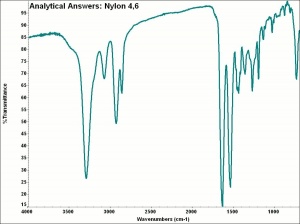Difference between revisions of "Nylon 4,6"
Jump to navigation
Jump to search
m (Text replace - "== Authority ==" to "== Sources Checked for Data in Record ==") |
|||
| (2 intermediate revisions by 2 users not shown) | |||
| Line 3: | Line 3: | ||
Nylon 4,6 is made by polymerizing 1,4-diaminobutane with adipic acid. Nylon 4,6 was introduced in 1984 as the fiber Stanyl. It is similar in most properties to nylon 6 and 6,6, but it has better dimensional stability. It is most often used in industrial applications. | Nylon 4,6 is made by polymerizing 1,4-diaminobutane with adipic acid. Nylon 4,6 was introduced in 1984 as the fiber Stanyl. It is similar in most properties to nylon 6 and 6,6, but it has better dimensional stability. It is most often used in industrial applications. | ||
| − | See [ | + | See [[nylon%20fiber|nylon fiber]]. |
| − | + | [[[SliderGallery rightalign|aaiNYLON-46.jpg~FTIR]]] | |
== Synonyms and Related Terms == | == Synonyms and Related Terms == | ||
Stanyl | Stanyl | ||
| − | + | ==Physical and Chemical Properties== | |
| − | |||
| − | == | ||
| − | |||
| − | |||
| − | |||
| − | |||
| − | |||
| − | |||
| − | |||
| − | |||
| − | |||
| − | |||
| − | |||
| − | |||
| − | |||
| − | + | * Tenacity = 9.5 g/denier | |
| + | * Melting Point = 300 | ||
| + | * Density = 1.18 | ||
| − | == | + | ==Resources and Citations== |
* Marjory L. Joseph, ''Introductory Textile Science'', Holt, Rinehart and Winston, Fort Worth, TX, 1986 | * Marjory L. Joseph, ''Introductory Textile Science'', Holt, Rinehart and Winston, Fort Worth, TX, 1986 | ||
Latest revision as of 12:57, 19 October 2022
Description
Nylon 4,6 is made by polymerizing 1,4-diaminobutane with adipic acid. Nylon 4,6 was introduced in 1984 as the fiber Stanyl. It is similar in most properties to nylon 6 and 6,6, but it has better dimensional stability. It is most often used in industrial applications.
See Nylon fiber.
Synonyms and Related Terms
Stanyl
Physical and Chemical Properties
- Tenacity = 9.5 g/denier
- Melting Point = 300
- Density = 1.18
Resources and Citations
- Marjory L. Joseph, Introductory Textile Science, Holt, Rinehart and Winston, Fort Worth, TX, 1986
